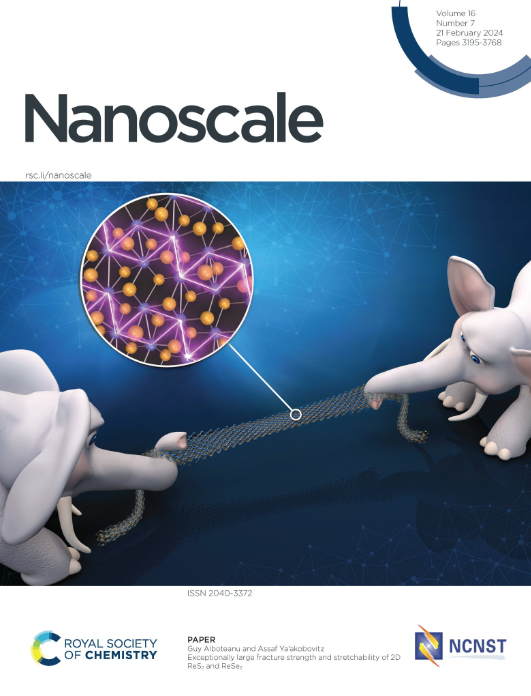CVD-Grown NiO-Carbon Nanofiber Decorated rGO Hybrids for High-Performance Electrochemical Hydrogen Storage: Role of Hierarchical Porous Structures
IF 5.1
3区 材料科学
Q1 CHEMISTRY, MULTIDISCIPLINARY
引用次数: 0
Abstract
The development of sustainable materials for green energy storage systems has accelerated due to the growing demand for energy worldwide and environmental concerns. Because of their high surface area, electrical conductivity, and adjustable structure, mesoporous graphitic carbon-based materials show the most promise for electrochemical hydrogen storage (EHS). These materials' electrochemical performance is further improved by integrating them with transition metal oxides. In this work, chemical vapor deposition was used to create hierarchically organized reduced graphene oxide/NiO-carbon nanofiber (rGO/NiO-CNF) hybrid materials with different ratios of rGO to NiO-CNF. In order to ascertain discharge capacity and the impact of composition on charge storage, cyclic voltammetry (CV) and galvanostatic charge-discharge techniques were used to examine a systematic electrochemical behavior. The kinetic or diffusion-controlled charge contributions of the electrocatalysts for EHS are examined. The successful decorating of rGO with NiO-CNFs was validated by structural and elemental studies, producing a porous, networked architecture that is conducive to charge accumulation and ion transport. The 1:1 rGO/NiO-CNF hybrid electrocatalyst showed the highest specific capacitance of 597.2 F/g and the best cycling stability over 50 cycles out of all the evaluated electrocatalysts. These findings establish rGO/NiO-CNF hybrids as potential materials for next-generation EHS systems by highlighting the crucial role that NiO-CNF content plays in improving hydrogen storage performance.cvd生长的镍碳纳米纤维修饰氧化石墨烯复合材料用于高性能电化学储氢:分层多孔结构的作用
由于全球对能源的需求不断增长和环境问题的关注,绿色储能系统的可持续材料的发展已经加速。介孔石墨碳基材料由于其高表面积、导电性和可调节结构,在电化学储氢(EHS)方面表现出最大的潜力。通过与过渡金属氧化物的结合,进一步提高了这些材料的电化学性能。在这项工作中,化学气相沉积被用于创建分层组织的还原氧化石墨烯/镍碳纳米纤维(rGO/NiO-CNF)混合材料,具有不同的rGO和NiO-CNF比例。为了确定放电容量和成分对电荷存储的影响,使用循环伏安法(CV)和恒流充放电技术来检查系统的电化学行为。考察了电催化剂对EHS的动力学或扩散控制电荷贡献。结构和元素研究验证了用NiO-CNFs修饰氧化石墨烯的成功,产生了有利于电荷积累和离子传输的多孔网络结构。1:1 rGO/NiO-CNF混合电催化剂的比电容最高,达到597.2 F/g,循环稳定性最好,超过50次循环。这些发现通过强调NiO-CNF含量在提高储氢性能方面的关键作用,确立了还原氧化石墨烯/NiO-CNF混合材料作为下一代EHS系统的潜在材料。
本文章由计算机程序翻译,如有差异,请以英文原文为准。
求助全文
约1分钟内获得全文
求助全文
来源期刊

Nanoscale
CHEMISTRY, MULTIDISCIPLINARY-NANOSCIENCE & NANOTECHNOLOGY
CiteScore
12.10
自引率
3.00%
发文量
1628
审稿时长
1.6 months
期刊介绍:
Nanoscale is a high-impact international journal, publishing high-quality research across nanoscience and nanotechnology. Nanoscale publishes a full mix of research articles on experimental and theoretical work, including reviews, communications, and full papers.Highly interdisciplinary, this journal appeals to scientists, researchers and professionals interested in nanoscience and nanotechnology, quantum materials and quantum technology, including the areas of physics, chemistry, biology, medicine, materials, energy/environment, information technology, detection science, healthcare and drug discovery, and electronics.
 求助内容:
求助内容: 应助结果提醒方式:
应助结果提醒方式:


